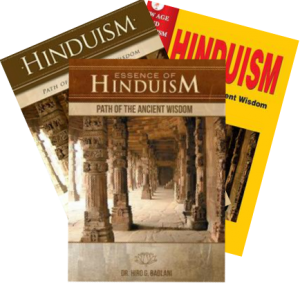Unlike the Western concept of linear time, the Hindus accept time as cyclical, with neither beginning nor end. Hindu Rishis have stated that there are eternal cycles of evolutions (srshti), and dissolutions (pralaya) taking place in the cosmos. The modern scientific opinion suggests that the whole cosmos was created by a “big bang” about 18 billion years ago. Our solar system was created 4.5 billion years ago. The solar system is a part of a larger galaxy of stars, the Milky Way. If we were seated in a spaceship zooming at the speed of light—186,000 miles per second—it would take 100,000 years to traverse from one end of the Milky Way galaxy to the other.1 There are billions of other galaxies of stars like this one. Many modern scientists including the famous physicist Stephen Hawking now tend to discredit the theory of “big bang” in favor of the Hindu concept of cosmos being eternal, without any beginning.
Hindu scriptures have given stunning descriptions of these infinite, countless solar systems (brahmands) in the cosmos. Hindus have two concepts of time periods: mythological and historical:
Mythological Concept: in this cosmic concept, Hindu Rishis conceived the largest measure of time as kalpa. One kalpa consists of 1000 smaller unite mahayugas. The current mahayuga is further divided as:
Satyuga period: 1,728,000 years
Tretayuga period: 1,296,000 years
Dwaparyug period: 864,000 years
Kaliyuga period: 432,000 years
Historical Concept: According to R.C. Majmudar, as described “Vedic Age” in the book, “The History and Culture of the Indian People” (1951:316) compiled by him, the four Yugas or periods of the Indian history are as follows:
Kritayuga——-Manu——3100 B.C.
Tretayuga——-Rama——1950 B.C.
Dvaparayuga—Krishna—1400 B.C.
Kaliyuga——————— (after Mahabharata war)
Hindu Rishis also recognized the cosmic phenomenon, and they called it Brahman—the transcendental, the supreme, the eternal divine soul, which pervades everything, everywhere, at all times. The concept of universal Brahman sowed the seeds of spiritual unity. The ancient Rishis recognized the utter vulnerability and weakness of man. They recognized the futility of man to depend upon his own ego. They compared man to a wave of the ocean; it rises and moves because it is with the ocean. Separated from it, the wave will perish in a moment. They compared the man to a whiff of air, to a bubble of water, to a speck of dust, and to a grain of sand. They teach that man must accept God in his own best interest. Pramukh Swami, the previous spiritual head of the Swaminarayan sect, was asked how he managed to do so much, despite his advanced age. He replied, “I completely trust the Supreme Lord. As I trust that the sun will rise in the morning and set in the evening, I trust that all things of life will be done with His grace. I don’t take any responsibility of the doer-ship on my shoulders. I simply work as per His instruction.” This in essence is the Hindu concept of religion—the Dharma as it is preferred to be called. It denotes cosmic unity of all beings, purity, righteousness and orderliness as ordained by the Supreme God. The scriptures define dharma as the natural universal laws whose observance enables man to save himself from degradation and suffering.
Hindu Rishis conceptualized “evolution” from a very early age; the perception of eternal cycles of evolutions (srshti), and dissolutions (pralaya) taking place from the infinite period, suggesting the everlasting movement of the changing cycles, forms the basis of Hindu doctrine and philosophy. It is incredible that Hindu Rishis made stunning descriptions of these countless solar systems (brahmands) in the cosmos over 5000 years ago, a time when technology was non-existent! Although the “big bang” theory is widely accepted by contemporary science, many, including the great physicist Stephen Hawking, are now inclined toward the ancient Hindu concept of the cosmos being eternal i.e going through recurring cycles of evolutions and dissolutions without an origin.




